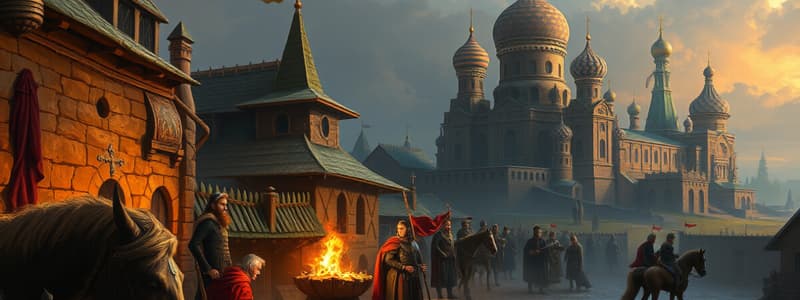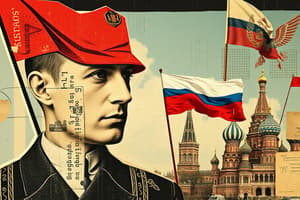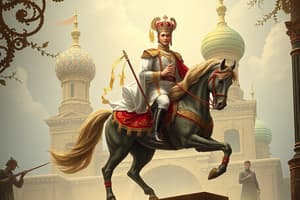Podcast
Questions and Answers
What notable change occurred in urban areas during Alexander II's reign?
What notable change occurred in urban areas during Alexander II's reign?
- The establishment of modern plumbing systems in houses.
- A significant rise in the urban population. (correct)
- A decline in the number of temporary migrants.
- The introduction of government-subsidized housing.
What type of housing became common in urban areas during Alexander II's reign?
What type of housing became common in urban areas during Alexander II's reign?
- Large apartment buildings with shared services.
- Communal houses known as 'kommunalkas.' (correct)
- Luxury flats for wealthy industrialists.
- Single-family homes with private yards.
Which factor limited the development of a working-class consciousness among urban workers during this period?
Which factor limited the development of a working-class consciousness among urban workers during this period?
- Strong labor unions advocating for worker rights.
- The temporary nature of many workers’ urban residency. (correct)
- Widespread access to education and cultural events.
- High levels of political organization among workers.
What cultural developments occurred in towns during the 1860s and 1870s?
What cultural developments occurred in towns during the 1860s and 1870s?
What was a significant characteristic of the urban working conditions during Alexander II’s reign?
What was a significant characteristic of the urban working conditions during Alexander II’s reign?
What type of industries flourished in the central industrial region during Alexander II's time?
What type of industries flourished in the central industrial region during Alexander II's time?
Which demographic shift occurred in small towns during the period?
Which demographic shift occurred in small towns during the period?
What was a feature of the living conditions in 'kommunalkas'?
What was a feature of the living conditions in 'kommunalkas'?
What was the primary benefit of the zemstvo in Russian towns and villages?
What was the primary benefit of the zemstvo in Russian towns and villages?
What was a notable change regarding working conditions established during Alexander II's reign?
What was a notable change regarding working conditions established during Alexander II's reign?
How did peasant living conditions change during Alexander II's reign?
How did peasant living conditions change during Alexander II's reign?
What factor contributed to the poor living conditions within the izba?
What factor contributed to the poor living conditions within the izba?
What limitation continued to affect agricultural practices post-emancipation?
What limitation continued to affect agricultural practices post-emancipation?
Why did mortality rates tend to be high among the peasantry in Russia during this period?
Why did mortality rates tend to be high among the peasantry in Russia during this period?
What was the condition of the agricultural production by 1900 compared to the population growth?
What was the condition of the agricultural production by 1900 compared to the population growth?
How did the aristocracy in Russia respond to the changes post-emancipation?
How did the aristocracy in Russia respond to the changes post-emancipation?
What effect did the rise of factories have on working conditions for poor workers?
What effect did the rise of factories have on working conditions for poor workers?
What role did energetic individuals like scientists and teachers play in the zemstvo?
What role did energetic individuals like scientists and teachers play in the zemstvo?
What was a characteristic feature of urban living conditions for workers during this period?
What was a characteristic feature of urban living conditions for workers during this period?
What did the Law on Factory Workers state regarding working hours for those aged 15–18?
What did the Law on Factory Workers state regarding working hours for those aged 15–18?
How did the overall conditions in both urban and rural settings during this period compare?
How did the overall conditions in both urban and rural settings during this period compare?
Flashcards are hidden until you start studying
Study Notes
Urban Living Conditions
- Urban population began to grow during Alexander II's reign, albeit at a slower pace compared to later rulers.
- Emergence of communal houses ("kommunalkas") housing multiple families, lacking basic amenities like plumbing and running water.
- Workers mainly consisted of temporary migrants from rural areas, preventing a significant working-class consciousness.
- Rapid cultural development in towns occurred; they became centers of political and legal life with a doubling of small town populations.
- Factories began to establish on town peripheries and landowners' estates, with industry thriving in regions like Ivanovo.
- Improvements in sanitation were implemented, including new pipelines, sewage systems, and paved roads.
- A vibrant local professional community emerged, contributing to a distinctive political culture through the zemstvo.
Urban Working Conditions
- Workers in industry represented a minor segment of the population, around 2%.
- Peasants engaged in temporary employment in towns, primarily for seasonal work such as harvests.
- Legislation began to regulate factory work, introducing a minimum working age of 12 and limited working hours for younger individuals.
- Unsafe working conditions persisted due to a lack of factory inspectors and safety equipment, with employer profit being the primary focus.
Rural Living Conditions
- Minimal change in peasant living conditions; traditional housing (Izba) remained uncomfortable and overcrowded.
- Life expectancy for Russian peasants was significantly lower (around 35 years) compared to Britain (45 years) during this period.
- Examination of land ownership revealed a decline among the nobility post-emancipation, resulting in decreased standards of living.
- Regions with significant state serf populations exhibited better living conditions due to more land, highlighting disparities across regions.
Rural Working Conditions
- Emancipation of the Serfs led to limited changes in agricultural practices and conditions for peasants.
- Average peasant received four hectares, but technological advancements in farming were largely absent.
- Redemption payments and taxation constrained peasants, leading to stagnation in agricultural productivity despite population growth.
- Railway developments facilitated better produce distribution and export, marking some advancement in infrastructure.
Concluding Points on Living and Working Conditions
- Overall, both urban and rural living conditions were harsh and challenging for the average Russian.
- Urban workers faced cramped and unhealthy living situations with increasing factory exploitation, especially among children.
- Peasant life remained tough, burdened by limited land ownership and dictated by the Mir, mirroring pre-1855 circumstances.
- While cultural and middle-class opportunities expanded in urban settings, the aristocracy and agrarian sectors faced stagnation and decline.
Studying That Suits You
Use AI to generate personalized quizzes and flashcards to suit your learning preferences.




